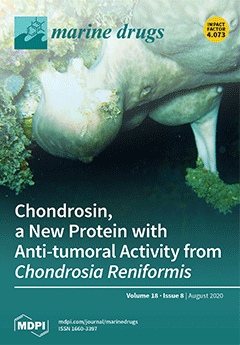Bioactivity-guided fractionation of a methanolic extract of the Red Sea cucumber
Holothuria spinifera and LC-HRESIMS-assisted dereplication resulted in the isolation of four compounds, three new cerebrosides, spiniferosides A (
1), B (
2), and C (
3), and cholesterol sulfate
[...] Read more.
Bioactivity-guided fractionation of a methanolic extract of the Red Sea cucumber
Holothuria spinifera and LC-HRESIMS-assisted dereplication resulted in the isolation of four compounds, three new cerebrosides, spiniferosides A (
1), B (
2), and C (
3), and cholesterol sulfate (
4). The chemical structures of the isolated compounds were established on the basis of their 1D NMR and HRMS spectral data. Metabolic profiling of the
H. spinifera extract indicated the presence of diverse secondary metabolites, mostly hydroxy fatty acids, diterpenes, triterpenes, and cerebrosides. The isolated compounds were tested for their in vitro cytotoxicities against the breast adenocarcinoma MCF-7 cell line. Compounds
1,
2,
3, and
4 displayed promising cytotoxic activities against MCF-7 cells, with IC
50 values of 13.83, 8.13, 8.27, and 35.56 µM, respectively, compared to that of the standard drug doxorubicin (IC
50 8.64 µM). Additionally, docking studies were performed for compounds
1,
2,
3, and
4 to elucidate their binding interactions with the active site of the SET protein, an inhibitor of protein phosphatase 2A (PP2A), which could explain their cytotoxic activity. This study highlights the important role of these metabolites in the defense mechanism of the sea cucumber against fouling organisms and the potential uses of these active molecules in the design of new anticancer agents.
Full article






